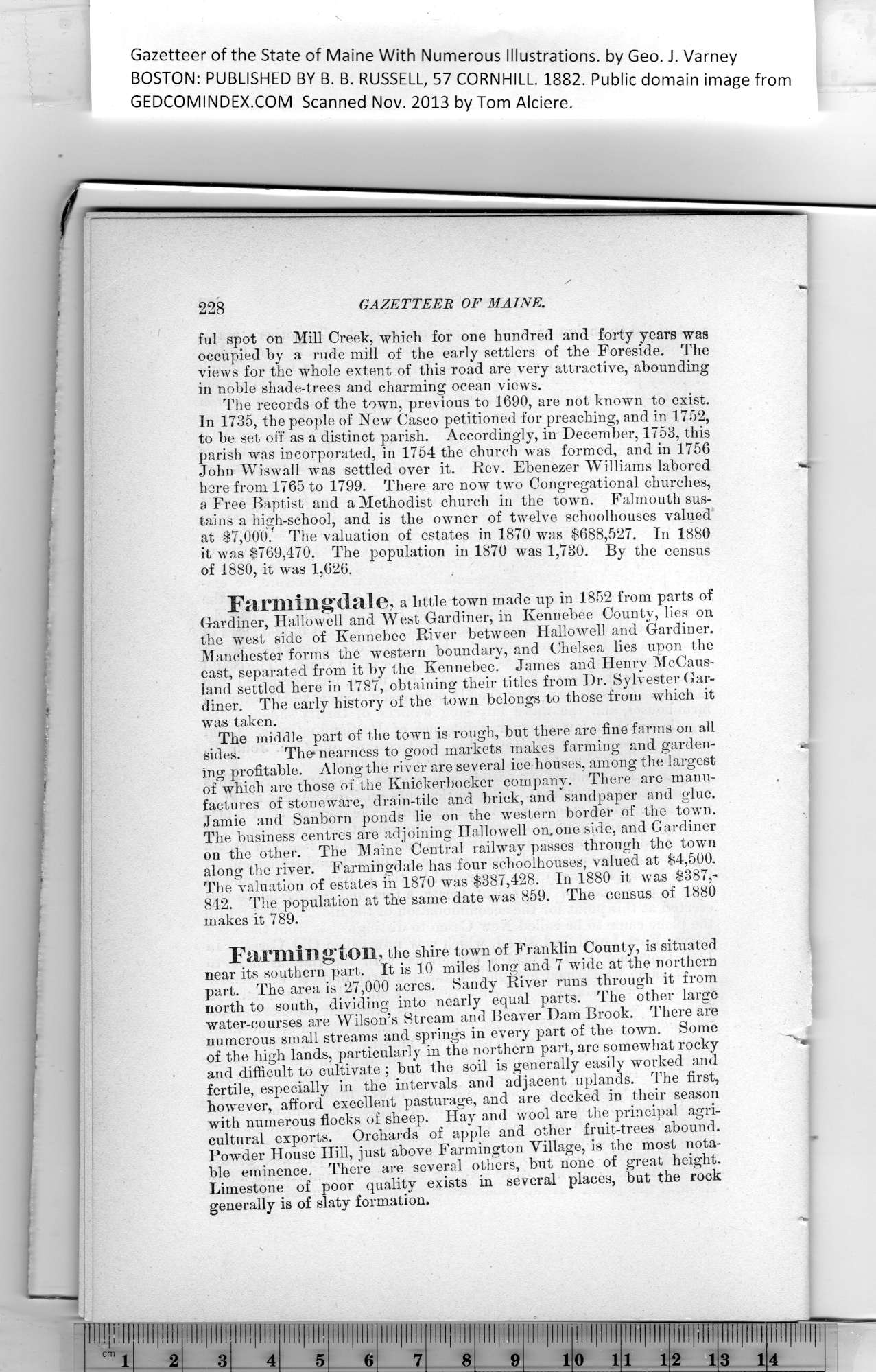|
Gazetteer of the State of Maine With Numerous Illustrations, by Geo. J. Varney
BOSTON: PUBLISHED BY B. B. RUSSELL, 57 CORNHILL. 1882. Public domain image from
GAZETTEER OF MAINE.
ful spot on Mill Creek, which for one hundred and forty years was
occupied by a rude mill of the early settlers of the Foreside. The
views for the whole extent of this road are very attractive, abounding
in noble shade-trees and charming ocean views.
The records of the town, previous to 1690, are not known to exist.
In 1735, the people of New Casco petitioned for preaching, and in 1752,
to be set off as a distinct parish. Accordingly, in December, 1753, this
parish was incorporated, in 1754 the church was formed, and in 1756
John Wiswall was settled over it. Rev. Ebenezer Williams labored
here from 1765 to 1799. There are now two Congregational churches,
a Free Baptist and a Methodist church in the town. Falmouth sus-
tains a high-school, and is the owner of twelve schoolhouses valued
at $7,000. The valuation of estates in 1870 was $688,527. In 1880
it was $769,470. The population in 1870 was 1,730. By the census
of 1880, it was 1,626.
Farmingdale, a little town made np in 1852 from parts of
Gardiner, Hallowell and West Gardiner, in Kennebee County, lies on
the wrnst side of Kennebec River between Hallotvell and Gardiner.
Manchester forms the western boundary, and Chelsea lies upon the
east, separated from it by the Kennebec. James and Henry McCaus-
land settled here in 1787, obtaining their titles from Dr. Sylvester Gar-
diner. The early history of the town belongs to those from which it
was taken.
The middle part of the town is rough, but there are fine farms on all
sides. The* nearness to good markets makes farming and garden-
ing profitable. Along the river are several ice-houses, among the largest
of which are those of the Knickerbocker company. There are manu-
factures of stoneware, drain-tile and brick, and sandpaper and glue.
Jamie and Sanborn ponds lie on the western border of the town.
The business centres are adjoining Hallowell on.one side, and Gardiner
on the other. The Maine Central railway passes through the town
along the river. Farmingdale has four schoolhouses, valued at $4,500.
The valuation of estates in 1870 was $387,428. In 1880 it was $387,-
842. The population at the same date was 859. The census of 1880
makes it 789.
Farmington, the shire town of Franklin County, is situated
near its southern part. It is 10 miles long and 7 wide at the northern
part. The area is 27,000 acres. Sandy River runs through it from
north to south, dividing into nearly equal parts. The other large
water-courses are Wilson’s Stream and Beaver Dam Brook. There are
numerous small streams and springs in every part of the town. Some
of the high lands, particularly in the northern part, are somewhat rocky
and difficult to cultivate ; but the soil is generally easily worked and
fertile, especially in the intervals and adjacent uplands. The first,
however, afford excellent pasturage, and are decked in their season
with numerous flocks of sheep. Hay and wool are the principal agri-
cultural exports. Orchards of apple and other fruit-trees abound.
Powder House Hill, just above Farmington Village, is the most nota-
ble eminence. There are several others, but none of great height.
Limestone of poor quality exists in several places, but the rock
generally is of slaty formation.
PREVIOUS PAGE ... NEXT PAGE
This page was written in HTML using a program written in Python 3.2
|
